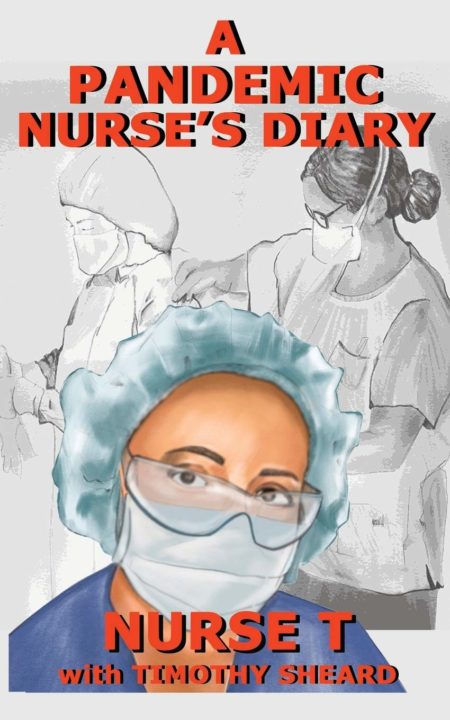A straightforward telling of one health worker’s story and her dedication to public health.
 It seems likely we will be hit with a giant wave of COVID-lit in the next few years, fiction and nonfiction coming to grips with the surreality of our ongoing pandemic. An early entry into the canon comes to us courtesy of Hard Ball Press, a labor-leftist small press that publishes fiction and nonfiction with working-class themes. In A Pandemic Nurse’s Diary “Nurse T” tells the story of the onset of COVID-19 and the toll it took from the perspective of her work at an unnamed New York City hospital that serves a poor community. Covering a period from January to August of 2020, Nurse T’s diary shows the institutional failures before the pandemic hit New York and the endless toil when it took hold.
It seems likely we will be hit with a giant wave of COVID-lit in the next few years, fiction and nonfiction coming to grips with the surreality of our ongoing pandemic. An early entry into the canon comes to us courtesy of Hard Ball Press, a labor-leftist small press that publishes fiction and nonfiction with working-class themes. In A Pandemic Nurse’s Diary “Nurse T” tells the story of the onset of COVID-19 and the toll it took from the perspective of her work at an unnamed New York City hospital that serves a poor community. Covering a period from January to August of 2020, Nurse T’s diary shows the institutional failures before the pandemic hit New York and the endless toil when it took hold.
Nurse T doesn’t tell us much about herself, but it seems she is an experienced nurse, with a husband and children. News of COVID-19 alarms her in January, but assorted doctors and other authority figures assure her there’s nothing to be worried about—some other authority figure, somewhere else, has a plan. Of course, no plan existed. As the intensive care unit starts to overflow in March, shortages of everything from sedatives to protective gear impede the nurses’ work. Nurse T works at an older hospital, where the rooms in the ICU do not maintain negative pressure when opened or closed, and they do not have fans to blow infected air out, creating “COVID bombs” blasting into the hallways of the hospital whenever anyone opens a door.
Some of the themes here will be familiar to readers of war stories. There’s the never-ending struggle with bureaucracy: Those room fans never arrive, and it’s never clear whose decision that is. We see trial by fire, most notably when an unproven young travel nurse fudges her qualifications before a shift at the height of the pandemic. Nurse T’s assessments of the doctors with whom she works—the “officers” to her senior NCO—range, like those in war stories, from the angry to the approving, perhaps more the latter. We witness the blessed relief Nurse T feels in rest, snacks, time with her family, and the (all-too-brief) relief of pressure when things get a little better in the summer. We see the camaraderie between the nurses and other health care workers. Above all, there is the omnipresence of death, of waste, of ghastly things happening to the human body. Worst of all, for this reviewer, was how frequently patients couldn’t be sedated properly while intubated, leading them to try to pull out their tubes and shamble out of bed, drowning in their own fluids.
Pandemics, like wars, reveal the fault lines of society and place them under great strain. Nurse T discusses the ways barriers of access that run along lines of class, race, and immigration status make her job treating patients harder. We know the story—poorer people and people worried about how authorities, medical or otherwise, will treat them don’t come into hospitals until absolutely necessary, by which time it is often too late. Always, collective goods—from exhaust fans in hospital rooms to an adequate public transport network—are neglected by those in power in favor of … what? Private goods, presumably, though that doesn’t seem to help Nurse T or her patients much. Either way, such an arrangement fails utterly in the face of a crisis like the pandemic and is continuing to do so.
Hard Ball Press has undertaken a genuine public service bringing this book, and the rest of its catalog of working-class writing, to the public. Nurse T is a nurse, not a professional writer. This shows sometimes in her prose—but shows more in positive ways: her straightforward telling of her story and her dedication to health, which even extends to creating several mental health meditation exercises for the reader at the end of the book. Hard Ball’s small size and dedication to labor writing granted it the nimbleness and passion to bring out this document of our time and potential important source for future historians.
A PANDEMIC NURSE’S DIARY. NURSE T WITH TIMOTHY SHEARS. HARD BALL PRESS. 155 PP.
Peter Berard is a writer and organizer who lives in Watertown, MA. For more of his work, check out peterberard.substack.com.

